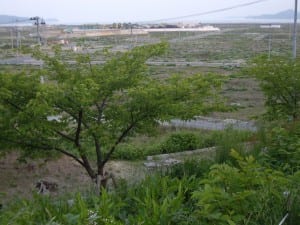Dr Joanna Faure Walker visited Rikuzentakata, one of the worst affected towns in the Iwate Prefecture, as part of the Great East Japan Earthquake EEFIT return mission. While there, she and her associates met with two NGOs: ‘Save Takata’ and ‘Sakura Line’ that were set up following the disaster.

Okamoto Shoma and his
mother Keiko Shoma in the
Save Takata office,
Rikuzentakata
In March 2011, Okamoto Shoma was a twenty-year-old architecture student in Tokyo who had grown up in Rikuzentakata. Following the tsunami, Okamoto and some class mates from Tokyo spent one and a half days driving to Rikuzentakata with recovery supplies and gasoline. Communications were down so Okamoto could not contact his mother, Keiko, whose house in Rikuzentakata had been destroyed by the tsunami. Fortunately he found her in an evacuation centre.
During the first month after the disaster, there were many requests from those outside the region about the residents’ safety and to make donations. Okamoto and his classmates formed Save Takata to help with coordination of the relief work; public services provided large-scale food and services, but additional help was needed to get smaller donations and reach small groups that needed assistance. It currently has a number of activities to help Rikuzentakata and its residents:
- Acting as a conduit and passive coordinator for people in Tokyo who want to donate money and expertise (examples include teaching and entertainment such as dance shows).
- Making up-to-date maps of Rikuzentakata permanent and temporary structures showing shop locations and distributing them to residents. (Initially conditions were changing rapidly so maps were updated every two months, going forward they will be updated every six months.)
- Promoting Rikuzentakata products and selling them in Tokyo and other big cities. (In 2011, 200,000 volunteers went to Rikuzentakata and in 2012 there were 130,000; Save Takata hopes to use this network)
- Providing internet services and I.T. training for small businesses.
- Informing residents and businesses about which relevant schemes are available to help them from around the country. (A particularly popular donation – especially amongst the elderly population – were small Buddha statues for people’s temporary homes.)
- Coordinating entertainment events such as festivals for children. (Keiko explained that although two years after the event the housing situation has become stable, people are bored and need community activities.)
- Renting a house for visiting volunteers; this house also acts as a meeting place and hub for activities for young people.
The Prefectural Government has made arrangements to employ people and dispatch them into jobs in NGOs; three of Save Takata’s eight full-time staff are with this scheme. Save Takata also has 2 part-time staff and 30 volunteer members. All staff originally volunteered their time, but now some salaries are being paid. In the early stages they relied on donations from private companies, however now they need to apply for support from both the private and public sectors. The organization is trying to transform from being a voluntary organization to having an increased amount of self-funding from the activities it organizes.
Save Takata’s future plans include producing a manual comprising the lessons learnt from setting up and running a NGO in a post disaster situation and being a NGO coordinator in potential future disasters as they recognize in a large disaster it is important to have good communication, coordination and organization between the different parties in the recovery process.
Okamoto is now also helping Sakura Line – the NGO that shares an office with Save Takata in a one-year-old temporary shopping centre – that was started by Hashizume Takumi.

Temporary shopping centre housing
the offices of
Save Takata and Sakura Line
Hashizume, who acted as a volunteer fireman helping people evacuate and closing the tsunami gate, escaped to high ground with only a few minutes to spare before the tsunami arrived. The disaster killed over fifty of his family and friends. Hashizume saw on television that historical tsunami had reached sacred places within cities in the region; he was angered when he saw there was a stone in Hinota marking where a historical tsunami had reached with a message instructing not to build houses lower than it. Hashizume feels it is his duty to pass on the message to future generations so decided to start Sakura Line, a project to create a continuous line of trees marking the border of the 2011 tsunami inundation.

One of the first cherry trees to be planted as part
of the Sakura Line programme. Behind the tree is
where downtown Rikuzentakata used to be.
The local government is currently raising the
ground level to 12m above sea level before
reconstructing the town.
The first trees were planted near the Judo Temple and other sites around Rikuzentakata. So far they have planted 520 trees. If completed, the line will extend beyond the city to become 170km long comprising 17,000 cherry trees. It is anticipated that it will take many years to finish. These trees live for about 100yrs so it is hoped that future generations will care for the trees and keep the line going. I hope his project receives the support it needs and acts as a successful reminder to future generations to help reduce the risk from future tsunami.
For more information on these projects see http://www.savetakata.org/en/ and http://www.sakura-line311.org/.
Dr Joanna Faure Walker was funded by EPSRC through EEFIT (http://www.eefit.org.uk). A new EEFIT report about observations made on the most recent trip in June 2013 will be available soon. The IRDR Special Report 2013-01 provides details about the observed damage and recovery of the Great East Japan Earthquake at and Tsunami in October 2012 (http://www.ucl.ac.uk/rdr/publications/IRDR-Special-Report-UK-Japan-Workshop) and the EEFIT Report provides observations from May-June 2011 (http://www.istructe.org/webtest/files/1d/1d158684-b77b-4856-99f8-2522fa25533b.pdf).
Filed under IRDR missions and projects
Tags: disaster risk reduction, Earthquake, EEFIT, Great East Japan Earthquake, Iwate, Japan, NGO, Rikuzentakata, Sakura Line, Save Takata, Tsunami
No Comments »

 Close
Close




